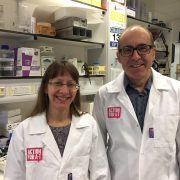Studying how genetic factors might reduce the severity of A-T
Research Project information
Principal researcher: Professor Steve Jackson and Dr Rimma Belotserkovskaya
Institute: The Gurdon Institute, University of Cambridge
Grant Awarded: £38,876
Project Completion Date: 30th September 2016
Project Overview
Steve and Rimma proposed to study cells derived from an Ataxia Telangiectasia (A-T) patient with unusually mild symptoms even though the patient had complete loss of ATM (the protein affected in A-T) 1. The patient therefore appears to have “resilience” to A-T. The basis of the research was to determine whether there is something special or different about the cells and genetic background of the patient that decrease A-T disease severity.
Research Methods and Outcome
This project had three main objectives:
- Sequence analyse the DNA isolated from this patient – DNA was prepared and subjected to whole genome sequencing at the Wellcome Trust Sanger Institute. This was successfully achieved.
- Generate pluripotent stems cells and differentiate these cells into neurons – by using recently established techniques this has been successfully achieved for this patient, “regular” A-T patients and healthy controls. This work is ongoing but at the time of writing the final report the team had successfully differentiated the isolated cells into neuroprogenitor cells in at least one of the cell lines.
- To analyse DNA damage responses in the stem cells and neurons – there was a delay in receiving the pluripotent stem cells at the Gurdon Institute so this has not yet been completed. Cells were expected to be established by December 2015 but were imported into the Gurdon Institute only in August 2016. As a result, this work is currently ongoing.
Publications
- Gabriel Balmus, Domenic Pilger, Julia Coates, Mukerrem Demir, Matylda Sczaniecka-Clift, Ana C. Barros, Michael Woods, Beiyuan Fu, Fengtang Yang, Elisabeth Chen, Matthias Ostermaier, Tatjana Stankovic, Hannes Ponstingl, Mareike Herzog1, Kosuke Yusa, Francisco Munoz Martinez, Stephen T. Durant, Yaron Galanty, Petra Beli, David J. Adams, Allan Bradley, Emmanouil Metzakopian, Josep V. Forment & Stephen P. Jackson; ATM orchestrates the DNA-damage response to counter toxic non-homologous end-joining at broken replication forks. Nature Communications volume 10, Article number: 87 (2019). Click here to read the full publication.
What next?
Further work is required to try to determine genetic components for A-T resilience. The team have recruited another patient with a mild form of A-T, and colleagues are currently analysing genomic DNA sequence and deriving iPS cells from that patient. Although this work has the potential to identify prognostic markers for A-T progression and therapeutic targets for alleviating the disease; this research is in its infancy. The team are currently applying for follow on studies.
References:
1. Worth, P. F. et al. Very mild presentation in adult with classical cellular phenotype of ataxia telangiectasia. Movement Disorders 28, 524-528 (2013).
Interview with Professor Steve Jackson





